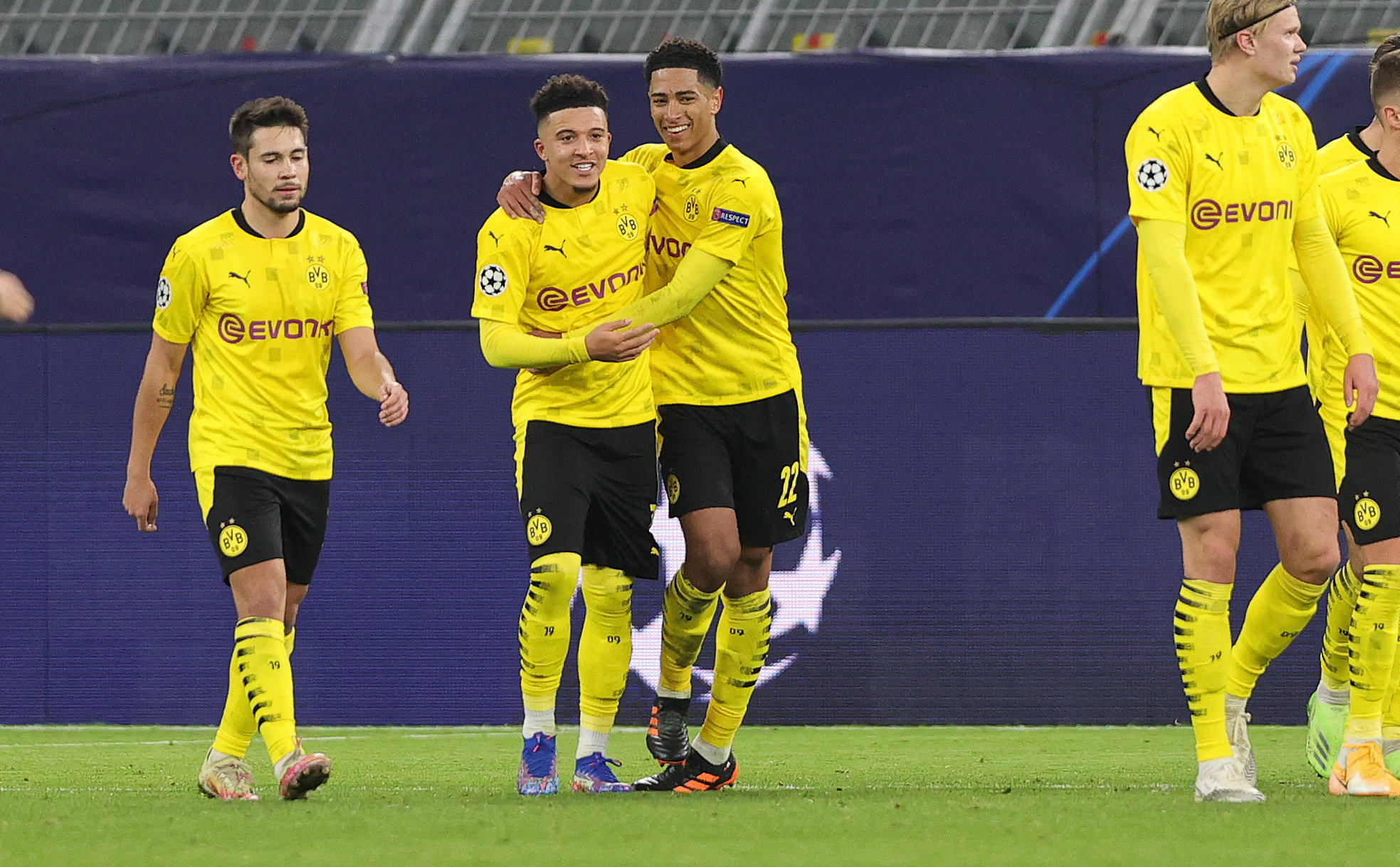Fraser Forster in 2016.
The first player based outside of England (in, er... Scotland) to be called-up for an England major tournament squad since Owen Hargreaves (Bayern Munich) and David Beckham (Real Madrid) for the 2006 World Cup.
With the recent trend of young English players turning their noses up at the perceived lack of available pathways at Premier League clubs, or seeking a cultural experience on different shores, there’s no denying that this generation of players are not shy of trying their hand away from home and it's highly likely Gareth Southgate's squad for this summer's Euros will contain at least one non-domestic based player.
Jadon Sancho’s 2017 move to Borussia Dortmund made him the poster boy for this movement, and he’s the obvious place to start in our round-up of young Lions that have landed in the German Bundesliga.
A rising star that went supernova is the only way to describe his 2019-20 season as Sancho contributed 32 non-penalty goals + assists (17G + 15A) at a rate of 1.21 per 90. Only Timo Werner (33 goals + assists) and, of course, Lionel Messi (39) contributed more in the big-5 leagues, and this was from a 20-year-old. The resultant hype was completely justified but expecting Sancho to repeat that was always going to be a big ask (for somebody not called Lionel Messi, at least).
To re-align expectations ahead of this season, one could point out that Sancho’s expected contribution numbers – his expected goals plus expected assists – for last season were behind, on a per 90 basis, those of Serge Gnabry, Christopher Nkunku, and Kevin Volland, to name just three in the Bundesliga.
All this to say, England's Bundesliga Beau has been having a tougher time of it in this campaign, netting just 2 goals and 5 assists in his 1287 minutes up to now. Let’s be clear, that’s still pretty good: it shakes out at a rate of 0.49 goals + assists per 90 - a goal or assist every 2 games. But, for a player many regard as having a talent worthy of gracing the pinnacle of the game, it’s not quite good enough.
Let’s look at the underlying numbers. This season is the first time in Sancho’s Dortmund career that he hasn’t overperformed on his expected numbers by quite a margin.
In 2018-19, he netted 25 G+A from 14.35 xG+xA. In 2019-20, it was 32 from 18.26. This season it’s 7 from 7.97. That’s comparing apples and oranges though, given the differences in playing time between the seasons. At a per 90 rate, his expected goal and assist numbers have remained strong across all three seasons: 0.49 in 18/19, 0.69 in 19/20, and 0.56 in 20/21. Whilst bearing in mind that 0.56 xG+xA per 90 is very impressive, it's still a noticeable drop on last season and suggests there's something going on besides the surface-level decline.
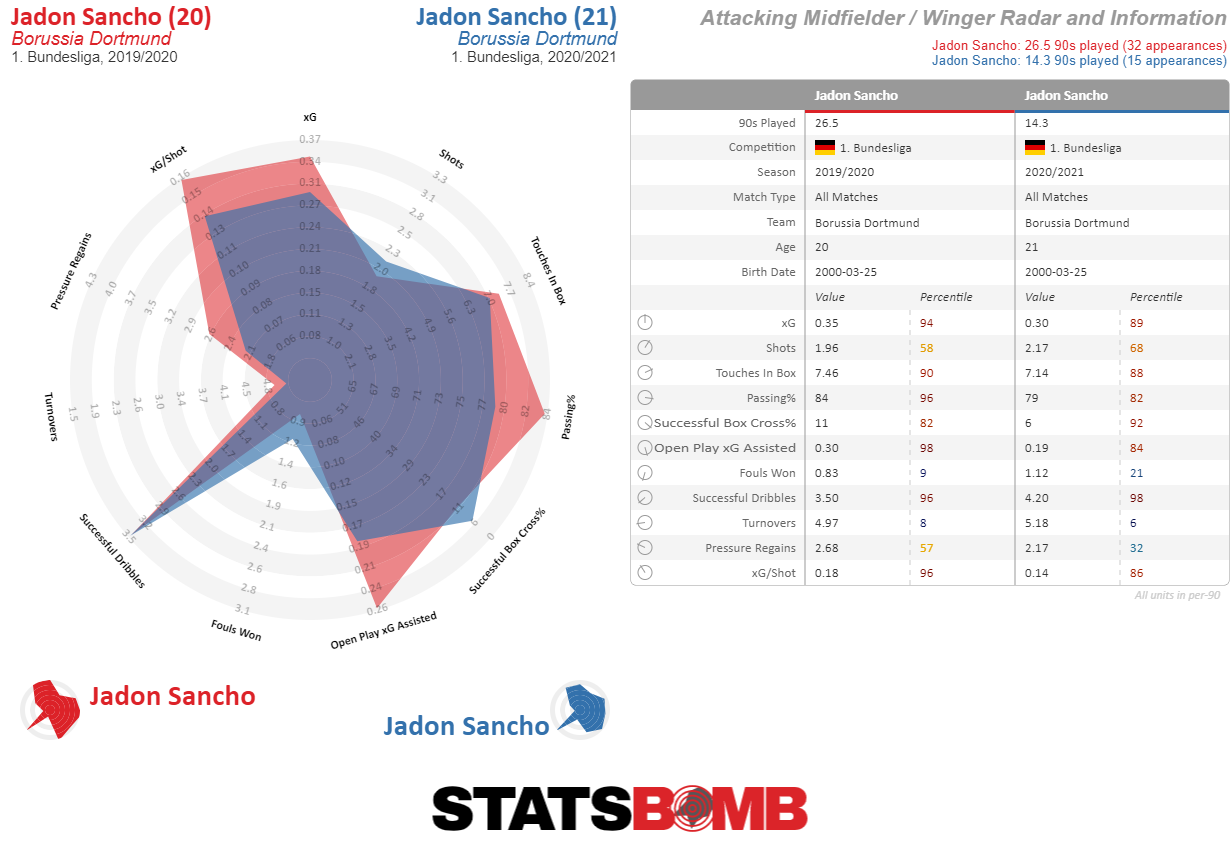
It's worth posing the question as to whether Sancho's issues are symptomatic of a bigger collective issue within Dortmund as a team, but no dice. Sort of. There is some symmetry between Sancho underperforming his expected numbers that Dortmund are also guilty of this season, but whilst Dortmund have improved their chance creation this season, Sancho’s output has receded. Let’s look into why.
His shot maps from the past three seasons reveal what might be going wrong in a goal scoring sense. There’s one type of chance that Sancho was getting previously that he hasn’t been this season: the high-probability, open-goal tap ins from ~6 yards out.
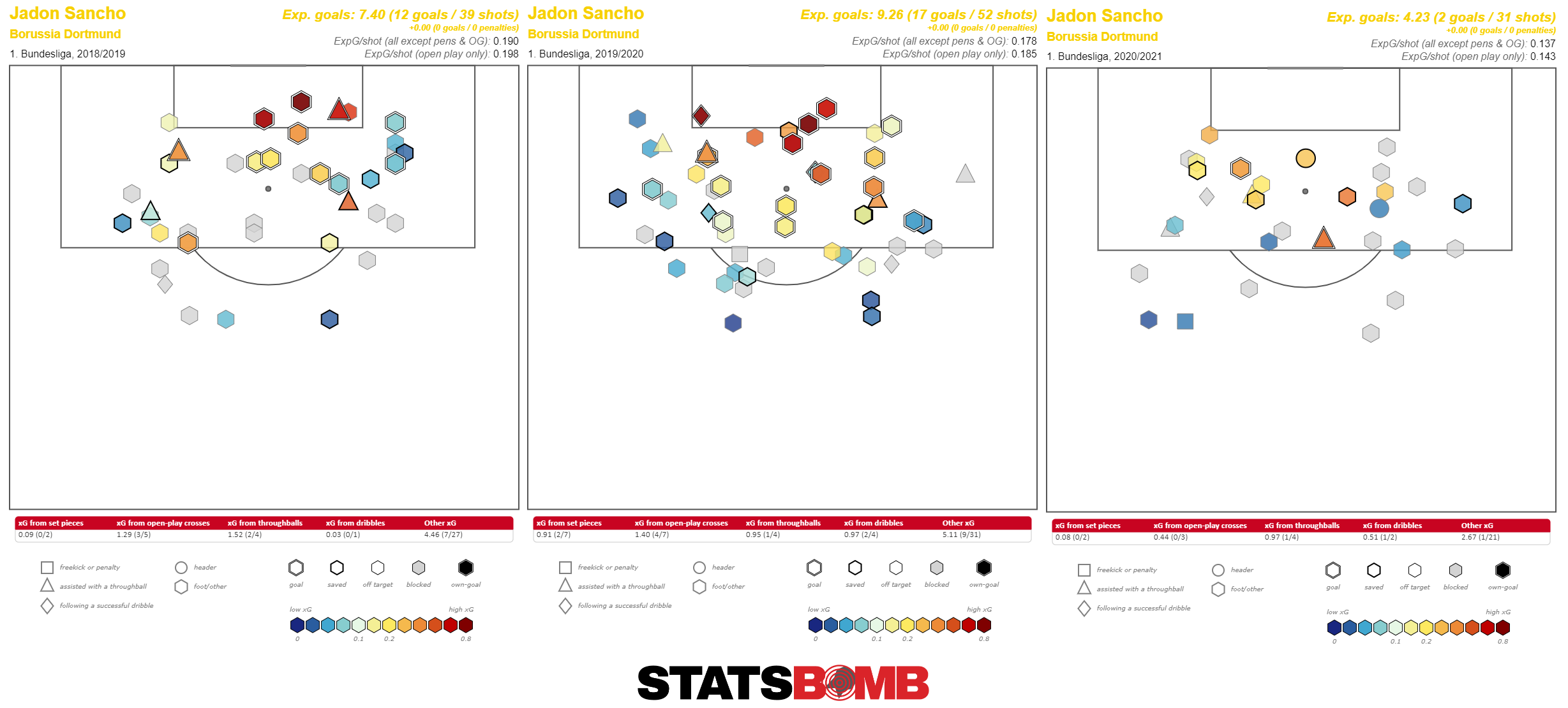
What is also obvious from the shot maps is that he just isn’t hitting the target as often this season. His Shooting % - the percentage of shots that are on target – is down from 54% last season to 23% this. Needless to say, that alone will cost you goals.
There are also issues creatively. His expected assist numbers in open play have dropped from a 1-in-3 expected-assister (0.30 OPxA) to a 1-in-5 expected-assister (0.19OPxA).
Drilling down, this appears to be an issue with his final ball. His dribbling numbers are up this season compared to last, as are his Open Play Passes Into the Box (3.57 per 90 up from 2.19), suggesting there's nothing wrong with Sancho's ability to progress the ball into dangerous areas. However, his passes completed inside the box have dropped from 1.09 per 90 in 19/20 to 0.49 per 90 this season. Once inside those dangerous areas, it's not coming off for him.
It could be that the increase in Successful Dribbles and Open Play Passes Into The Box but decline in goal-contributions are because Sancho’s playing a bigger role earlier in the attacking phase and he just hasn't been required to lay on the chances or apply the finishing touch as much as he was last season. Well, that theory gets debunked too when looking at the xGChain – a model that attributes the xG value of the final shot to all players involved in the entire possession - of Dortmund’s squad over the last two seasons.
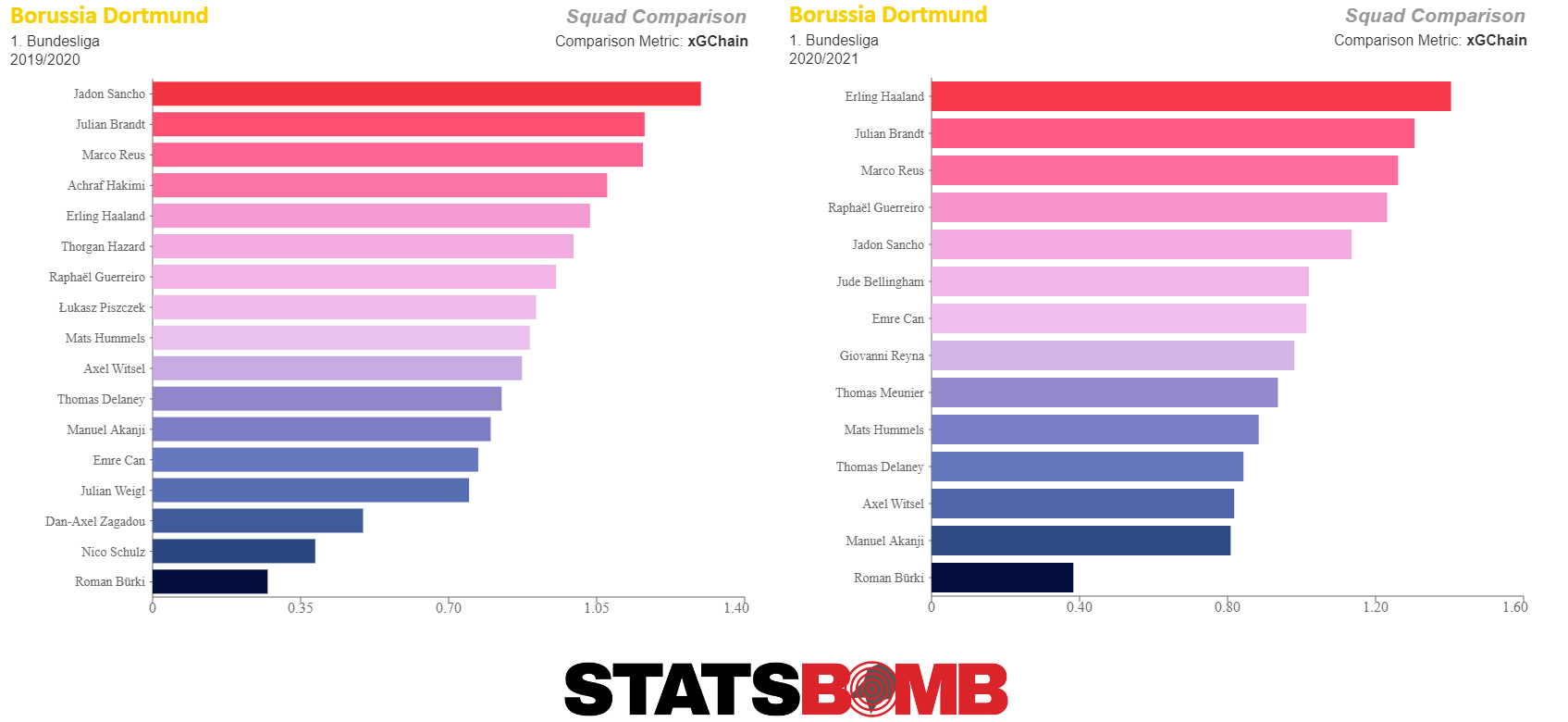
Sancho was consistently involved in Dortmund’s most-productive attacking moves in 2019/20, whereas he’s far less involved this time. So, either Dortmund aren’t moving the ball through Sancho as much or Sancho is being more wasteful with the ball.
The data would appear to suggest the latter. His pass completion % (I know, I know) is down from 84% to 79%, his Dispossessed rate is up, and so are the number of Turnovers he's registering.
Overall, it's been a much tougher campaign for the starlet this time out, but it needs stressing that this is in the context of his very, very high standards. It’ll be interesting to see whether his form picks up at all under new Dortmund interim coach Edin Terzic, following Lucien Favre’s sacking.
Sharing the Dortmund dressing room with Sancho is Jude Bellingham, who's enjoying another positive campaign.
In case you need reminding, Bellingham banked 32.0 English Championship 90s last season at the age of 16(!). He can’t drink or drive, but he can outclass experienced professionals twice his age and look comfortable in a physically demanding league. Those who watched him last season will know that the amount of first team minutes was in no way premature, nor was the transfer and size of fee that sealed his move to Dortmund, and nor are the steady stream of minutes he’s now getting in the centre of one of the most talented teams in the world.
A mix of starts and appearances off the bench has seen him feature in 7.8 90s - about 40% of the league minutes available so far - and he’s already making an impression in the Bundesliga. Bellingham famously wears the #22 shirt because he can play in all of the ‘4’, ‘8’, or ‘10’ midfield roles and his Jude-of-all-trades skillset has been on display: contributing in breaking up opposition attacks, playing combination passes in buildup, carrying the ball through the centre of the pitch, or making runs beyond the defensive line to get on the end of chances.
With the extreme caveats that he’s only featured in <8 games worth of minutes so far and will have enjoyed the sub-effect benefits of having fresh legs off the bench, here’s how his output this season compares with his output at Birmingham last season.
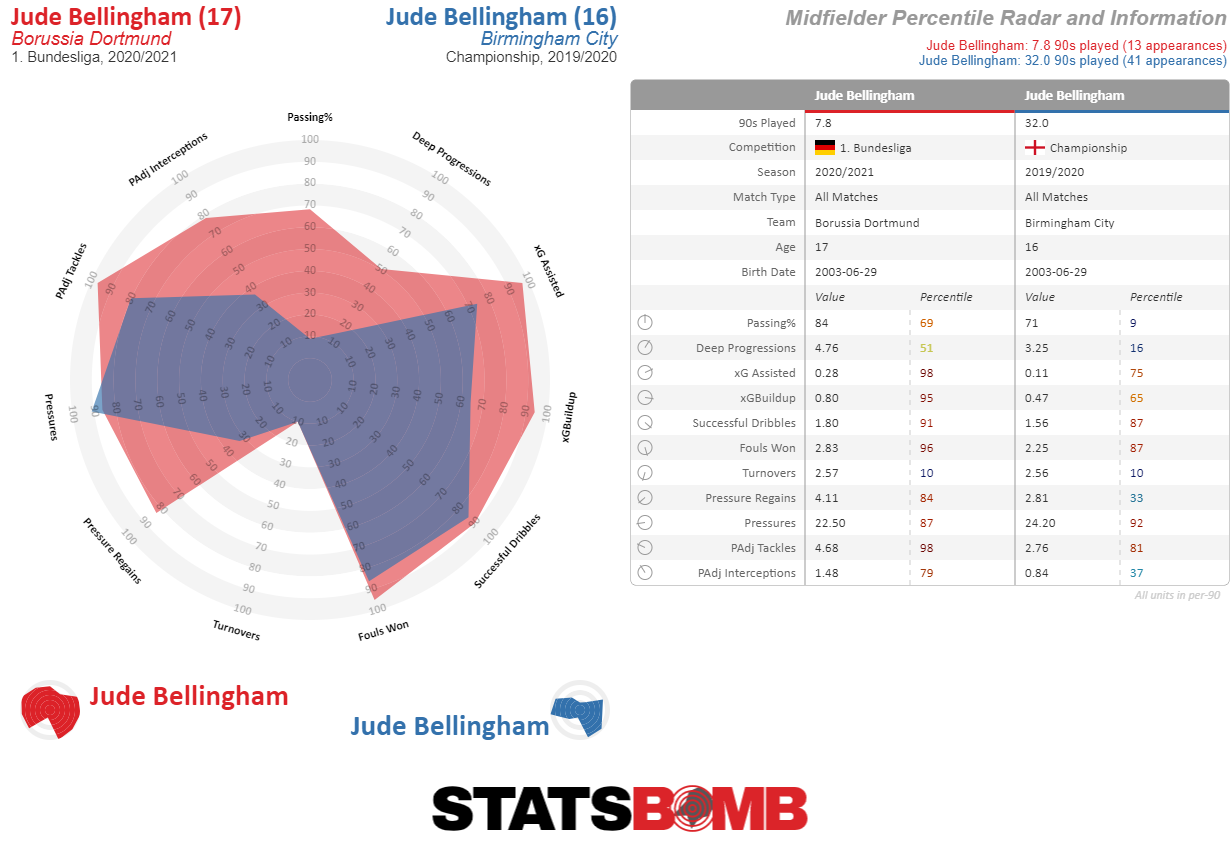
Stepping foot on the pitch for a club of Dortmund’s pedigree at his age would be a good enough indicator of his talent, but Bellingham has already been having a positive influence on the team and making a valuable contribution in every third. Add in the fact that he made his England Under-21 debut in September and his senior England debut in November, it’s been another season of rapid progression for the youngster and there’s half of it still to play. Not bad for a kid who turned 17 in June.
As if one 2003-born Englishman getting regular Bundesliga minutes at a German giant wasn’t enough, Jamal Musiala makes it two having muscled his way into the Bayern Munich first team setup this season.
Moving to Bayern’s youth setup from Chelsea in the summer of 2019, Musiala became the Bavarian behemoth’s youngest ever Bundesliga player when he came off the bench against Freiburg at the end of the 2019-20 season, aged 17 years and 115 days. It’s said that even Bayern are surprised by the speed at which he has progressed since joining the club: in just over a year, Musiala has moved through Bayern’s under-17’s, under-19’s, and reserve team to join the first team.
This season has been another leap in his rapid progression. Musiala has made 13 Bundesliga appearances – 2 starts, 11 off the bench – and has accrued 405 minutes by the mid-way point in the season. Like Bellingham, these aren’t token minutes geared at giving them experience and game time, Musiala has also made telling contributions to Bayern’s season already, his technical ability and impressive work ethic out of possession showing him to be already capable of contributing at this level. It’s a similar story in the England youth setup, with him making his Under-21’s debut in November. Some of his teammates and opponents in that game were five years his senior.
His first goal, becoming Bayern’s youngest ever goal scorer in the process, came on the opening day in the 8-0 thrashing of Schalke 04, cutting in from the left flank to finish clinically inside the near post from 16-yards, but his most impressive moment so far came in the top of the table clash against RB Leipzig on December 1st.
Having made his first start for the club versus Werder Bremen two weeks prior, Musiala was trusted to be first sub off the bench on 24 minutes after an injury to Javi Martínez, coming on ahead of a more direct replacement in Marc Roca. He made his mark within 5 minutes of coming on, bringing the scores level with another technically-accomplished finish from the edge of the area.
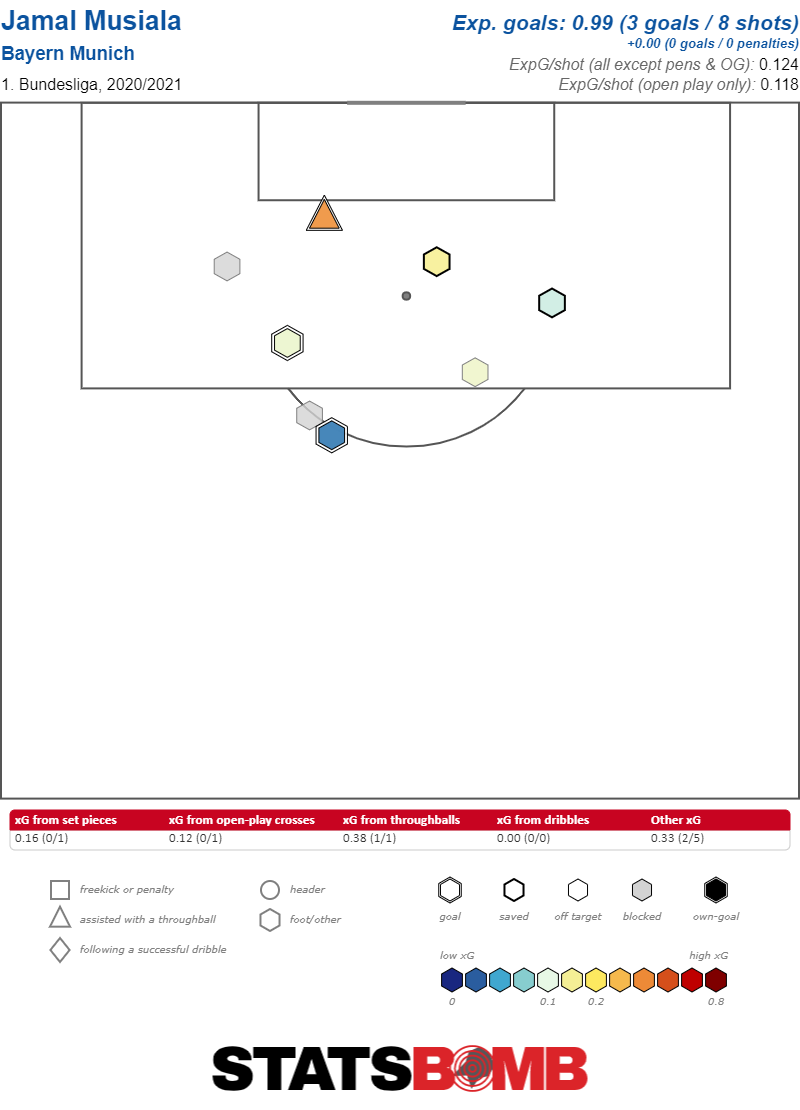
A series of impressive cameos and goal scoring contributions have justified Hansi Flick’s trust in throwing him into the first team so quickly and it leaves him in a good position to continue picking up valuable development time on the pitch and take part in a title race in the second half of the season.
Last but not least: Ryan Sessegnon.
With Spurs seemingly viewing Sessegnon's long-term future at left-back, as opposed to a more advanced role, a move to a club that would a) play him there but b) allow him to harness his innate attacking instincts was key for his development. It looks like he's found that at Hoffenheim.
On the surface, it’s so far, so good. He’s getting the game time he desired when making the move, playing 891 minutes – 54% of the available minutes in the Bundesliga - and his performances have been productive too, netting two goals in trademark style: calm, close-range finishes from the left-hand channel of the box after making a run inside from the wing. Sessegnon's form was so good in November that he won the club's player of the month award.
Means a lot to have been voted by the fans as the @tsghoffenheim Player of the Month and appreciate all the support I've been given since joining. Enjoying being a part of the team and will keep working hard to achieve our goals for this season. Vielen Dank! 🙏🏿 💙 #TSG pic.twitter.com/jpkFvbpaI4
— Ryan Sessegnon (@RyanSessegnon) December 2, 2020
The regular gametime in his long-term position has been crucial to Sessegnon's progression after an injury-hit first season at Spurs. Playing at left back in the Bundesliga will develop his defensive game through being tested by the calibre of wide players found in a top 5 league, but Hoffenheim's style of play also allows him to continue to influence the game in the final third. His touch map shows that he has the license to play his natural game, get up and down the flank and come inside to attack the box when Hoffenheim are in the attacking phase.

Things are looking rosy for the latest set of English imports to the Bundesliga. There's plenty of reason to keep a close eye on their development and progress in the home stretch of the campaign.
Join us at StatsBomb Evolve on March 17th 2021 to discover how we're going to change the football industry, including the launch of our new data product, StatsBomb 360. To find out more, click here.
